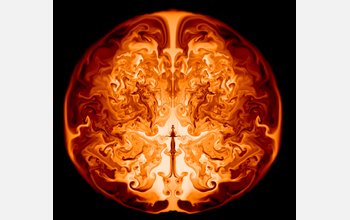Multimedia Gallery
Slice Through the Interior of a Supermassive Star
This visualization is a slice through the interior of a supermassive star of 55,500 solar masses along the axis of symmetry. It shows the inner helium core in which nuclear burning is converting helium to oxygen, powering various fluid instabilities (swirling lines). This "snapshot" from a simulation shows one moment a day after the onset of the explosion, when the radius of the outer circle would be slightly larger than that of the orbit of the Earth around the sun.
Exploding supermassive stars may be a missing link in our understanding of structure formation in the early universe. Observational evidence reveals that supermassive black holes--millions to billions times more massive than our sun--reside at the center of almost every galaxy, including the ancient bright quasars that existed already when the universe was only a billion years old.
Astrophysicists struggle to explain how such supermassive black holes could form so early in the universe. Some theoretical models suggest they could have originated from supermassive stars--stars of 10,000-plus solar masses--that collapse into black holes. Such supermassive black holes then accrue more matter and merge along with the merger of their host galaxies until they reach the observed sizes. All previous stellar evolution models have suggested that primordial stars over 300 solar masses would simply die as black holes.
Surprisingly, however, supercomputing simulations have revealed that supermassive stars of around 55,000 solar masses also can explode as supernovae. While the star burns helium in its core, it becomes dynamically unstable because of an effect from general relativity. This triggers a rapid collapse of the star and ignites explosive thermonuclear burning. The star explodes so violently that no black hole at all is left behind.
This research was supported by a grant from the National Science Foundation (grant AST 11-09394, "Collaborative Research: On the Road to the Supernova: LBVs, Hypergiants and SN Impostors)," awarded to Roberta Humphreys at the University of Minnesota, Twin Cities. (Date of Image: July 2011)
Credit: Ke-Jung Chen, Minnesota Institute for Astrophysics, University of Minnesota-Twin Cities
Images and other media in the National Science Foundation Multimedia Gallery are available for use in print and electronic material by NSF employees, members of the media, university staff, teachers and the general public. All media in the gallery are intended for personal, educational and nonprofit/non-commercial use only.
Images credited to the National Science Foundation, a federal agency, are in the public domain. The images were created by employees of the United States Government as part of their official duties or prepared by contractors as "works for hire" for NSF. You may freely use NSF-credited images and, at your discretion, credit NSF with a "Courtesy: National Science Foundation" notation.
Additional information about general usage can be found in Conditions.
Also Available:
Download the high-resolution JPG version of the image. (12.2 MB)
Use your mouse to right-click (Mac users may need to Ctrl-click) the link above and choose the option that will save the file or target to your computer.

